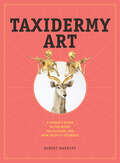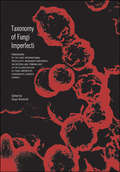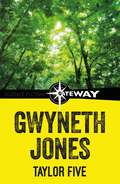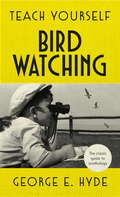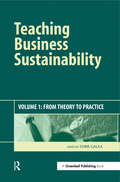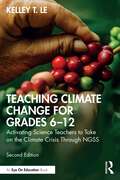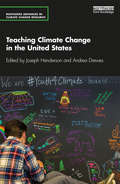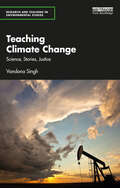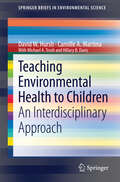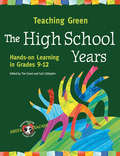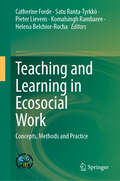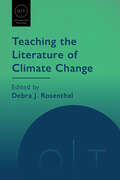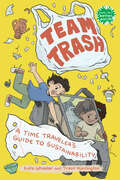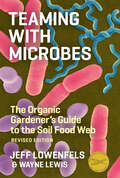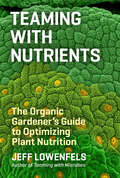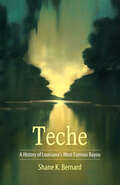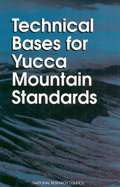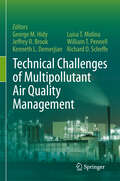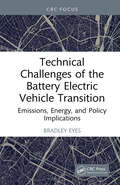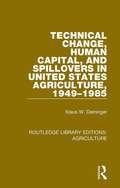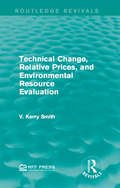- Table View
- List View
Taxidermy Art: A Rogue's Guide to the Work, the Culture, and How to Do It Yourself
by Robert MarburyIn this collection of taxidermy art, you’ll find a winged monkey with a fez and a martini glass, a jewel-encrusted piglet, a bionic fawn, and a polar bear balancing on a floating refrigerator. Author Robert Marbury makes for a friendly (and often funny) guide, addressing the three big questions people have about taxidermy art: What is it all about? Can I see some examples? and How can I make my own? He takes readers through a brief history of taxidermy (and what sets artistic taxidermy apart) and presents stunning pieces from the most influential artists in the field. Rounding out the book are illustrated how-to lessons to get readers started on their own work, with sources for taxidermy materials and resources for the budding taxidermist.
Taxonomy of Fungi Imperfecti: Proceedings of the First International Specialists' Workshop Conference on Criteria and Terminology in the Classification of Fungi Imperfecti, Kananaskis, Alberta, Canada
by Bryce KendrickMycologists have been searching for a better system of classification of Fungi Imperfecti than that based on mature morphology. This volume documents an intensive phase of that search. It is largely an account of the proceedings of the First International Specialists' Workshop Conference on Criteria and Terminology in the Classification of Fungi Imperfecti held at the Environmental Sciences Centre of the University of Calgary, Kananaskis, Alberta. The invited contributors, all mycologists of international reputation, have had long experience with Fungi Imperfecti. The first fifteen chapters follow the course of the conference: they reproduce the formal papers and the lively discussion which followed. Chapter 16 describes a new, experimental scheme of classification distilled from the conclusions reached at Kananaskis. Four chapters concerned with the application of this scheme and with a variety of techniques now being used to extend knowledge of the Fungi Imperfecti round out the volume. The text is illustrated throughout with numerous photographs and drawings. In editing the volume, Professor Kendrick has given the text continuity by inserting short linking passages. The result is a readable and very informative account which conveys the unique atmosphere of this important conference.
Taylor Five
by Ann Halam Gwyneth JonesTaylor Walker seems like any ordinary 14-year-old . . . if you overlook the fact that she lives on the island of Borneo, on a primate reserve run by her parents, and knows how to survive in the jungle. Tay isn't just like everyone else. But she is like one other person. She's exactly like one other person. Tay is a clone, one of only five in the world, and her clone mother is Pam Taylor, a brilliant scientist.When rebels attack her home, Tay escapes with her younger brother and Uncle, an exceptionally intelligent orangutan. As they flee for their lives, Tay must look within to find her strength: Pam's DNA, tempered by Taylor's extraordinary life. She's not alone, and she might be a clone, but she's also unique.
Taylor Five
by Ann Halam Gwyneth JonesTaylor Walker seems like any ordinary 14-year-old . . . if you overlook the fact that she lives on the island of Borneo, on a primate reserve run by her parents, and knows how to survive in the jungle. Tay isn't just like everyone else. But she is like one other person. She's exactly like one other person. Tay is a clone, one of only five in the world, and her clone mother is Pam Taylor, a brilliant scientist.When rebels attack her home, Tay escapes with her younger brother and Uncle, an exceptionally intelligent orangutan. As they flee for their lives, Tay must look within to find her strength: Pam's DNA, tempered by Taylor's extraordinary life. She's not alone, and she might be a clone, but she's also unique.
Teach Yourself Bird Watching: The classic guide to ornithology
by GE HydeWith a few sorry exceptions, it's heartening to think that the gardener or bird-spotter of the 1950s or 60s would immediately recognise most of the songs that sing out over English gardens today. For the amateur ornithologist of the twenty first century, Teach Yourself Bird Watching will be as much of a delight now as it ever was - a beautifully written, precise guide to identifying, protecting and encouraging birdlife in your garden and beyond.Since 1938, millions of people have learned to do the things they love with Teach Yourself. Welcome to the how-to guides that changed the modern world.
Teach Yourself Bird Watching: The classic guide to ornithology (Teach Yourself)
by George E. HydeWith a few sorry exceptions, it's heartening to think that the gardener or bird-spotter of the 1950s or 60s would immediately recognise most of the songs that sing out over English gardens today. For the amateur ornithologist of the twenty first century, Teach Yourself Bird Watching will be as much of a delight now as it ever was - a beautifully written, precise guide to identifying, protecting and encouraging birdlife in your garden and beyond.Since 1938, millions of people have learned to do the things they love with Teach Yourself. Welcome to the how-to guides that changed the modern world.
Teach Yourself Weather
by Peter InnessTeach Yourself Weather shows you how to interpret the nightly weather report and even make your own predictions. It examines climate change and its effect on the weather.
Teaching Business Sustainability: From Theory to Practice
by Chris GaleaThere are many challenges facing educators in the field of sustainability. This text aims to analyze the state of the art in teaching business sustainability worldwide, and what teaching practices and tools are achieving successful results.
Teaching Climate Change for Grades 6–12: Activating Science Teachers to Take on the Climate Crisis Through NGSS
by Kelley T. LêLooking to tackle climate change and climate science in your classroom? This timely and insightful book supports secondary science teachers in developing effective curricula around the Next Generation Science Standards (NGSS) by grounding their instruction on the climate crisis. This new edition focuses on meeting teachers where they are in their teaching and learning while tending to various contexts, communities, and cultures to activate educators in understanding and responding to the climate crisis in this moment. Chapters offer design and implementation support for 21st-century learning experiences centered around the climate emergency for meaningful engagement. Dr. Lê provides an overview of the teaching shifts needed for the NGSS using climate change as the vehicle of instruction. She also supports climate literacy for students and teachers via urgent topics in climate science and environmental justice. Teachers will also learn how to engage with the complexities of climate change by exploring social, racial, and environmental injustices stemming from the climate crisis that directly impact their students. Examples of successful applications of these learning experiences are new to the second edition, as well as added activities and overall updates to research and data. By anchoring instruction on the climate emergency through an intersectional lens starting with teachers’ core beliefs and values, Dr. Lê offers guidance on how educators can activate students as agents of change for their own communities.
Teaching Climate Change in the United States (Routledge Advances in Climate Change Research)
by Joseph Henderson Andrea DrewesThis book highlights best practices in climate change education through the analysis of a rich collection of case studies that showcase educational programs across the United States. Framed against the political backdrop of a country in which climate change denial presents a significant threat to global action for mitigation and adaptation, each case study examines the various strategies employed by those working in this increasingly challenging sociopolitical environment. Via co-authored chapters written by educational researchers and climate change education practitioners in conversation with one another, a wide range of education programs is represented. These range from traditional institutions such as K-12 schools and universities to the contemporary learning environments of museums and environmental education centres. The role of mass media and community-level educational initiatives is also examined. The authors cover a multitude of topics, including the challenge of multi-stakeholder projects, tensions between indigenous knowledge and scientific research, education for youth activism, and professional learning. By telling stories of success and failure from the field, this book provides climate change researchers and educators with tools to help them navigate increasingly rough and rising waters.
Teaching Climate Change: Science, Stories, Justice (Research and Teaching in Environmental Studies)
by Vandana SinghTeaching Climate Change: Science, Stories, Justice shows educators how climate change can be taught from any disciplinary perspective and in a transdisciplinary way, drawing on examples from the author's own classroom. The book sets out a radical vision for climate pedagogy, introducing an innovative framework in which the scientific essentials of climate change are scaffolded via three transdisciplinary meta-concepts: Balance/Imbalance, Critical Thresholds and Complex Interconnections. Author Vandana Singh grounds this theory in practice, drawing on examples from her own classroom to provide implementable ideas for educators, and to demonstrate how climate change can be taught from any disciplinary perspective in a transdisciplinary way. The book also explores the barriers to effective climate education at a macro level, focusing on issues such as climate misinformation/misconception, the exclusion of social and ethical concerns and a focus on technofixes. Singh uses this information to identify four key dimensions for an effective climate pedagogy, in which issues of justice are central: scientific-technological, the transdisciplinary, the epistemological and the psychosocial. This approach is broad and flexible enough to be adapted to different classrooms and contexts. Bridging the social and natural sciences, this book will be an essential resource for all climate change educators practicing in both formal and informal settings, as well as for community climate activists.
Teaching Environmental Health to Children
by David W. Hursh Hilarie B. Davis Camille A. Martina Michael A. TrushEvery day we are exposed to toxins and toxicants that can impact our health. Yet we rarely teach elementary and secondary students about these exposures and how they can reduce their risk to them. In this book we highlight activities and curriculum developed at nine universities in the United States from a grant funded by the National Institute of Environmental Health Sciences. Our goal is to extend these lessons to a global audience and for classroom teachers of all subjects and age levels to include environmental health in their teaching. 'An invaluable tool for equipping informed citizens to think about the environment and its human impacts --both the science, and equally important, the social and ethical dimensions' , Howard Frumkin, M.D., Dr. P.H., Dean, School of Public Health, University of Washington, Seattle, WA, USA
Teaching Green - The High School Years
by Tim Grant Gail LittlejohnThis resource is ideal for anyone working with young people in grades 9-12, whether in schools or in non-formal educational settings. Richly illustrated, it offers fifty teaching strategies that promote learning about natural systems and foster critical thinking about environmental issues, both local and global. It contains new approaches to learning, strategies for living sustainably, and numerous activities that promote interdisciplinary learning. In addition, the book provides suggestions for how best to green individual subject areas, develop integrated learning programs, or replicate exemplary programs created by innovative schools and communities.Containing contributions from over sixty educators from across North America, the book's strength lies in its diverse content. Readers learn how best to apply systems thinking, teach about controversial issues, and use a step-by-step approach to creative problem-solving in environmental projects. Also provided are instructions for measuring the ecological footprint of a high school, creating an indoor "living system" that cleans water, monitoring air quality with lichens, and using green technologies to help green school campuses. Many articles and activities engage teenagers in outdoor learning and community restoration projects. Suggestions are included for connecting students with special needs to the environment around them.Readers will find accessible background information and suggestions for many practical projects and activities. It is sure to appeal to a wide range of teachers, educators, and parents seeking innovative ideas for incorporating green themes into their programs.Tim Grant and Gail Littlejohn are the editors of Green Teacher magazine, North America's award-winning environmental teaching resource.
Teaching Kids To Love The Earth
by Marina LacheckiTeaching Kids to Love the Earth is a collection of 186 earth-caring activities designed for use with children of all ages to help them experience and appreciate the earth. This book leads you through the authors&’ Sense of Wonder Circle: curiosity, exploration, discovery, sharing, and passion. Each chapter contains a story, instructions for a main activity, suggestions for related activities, and a lsit of additional resources. Teaching Kids to Love the Earth will enable you and the children you work with to experience a &“sense of wonder&” about the world we share.
Teaching and Learning in Ecosocial Work: Concepts, Methods and Practice
by Catherine Forde Satu Ranta-Tyrkkö Pieter Lievens Komalsingh Rambaree Helena Belchior-RochaThis book aims to champion teaching and learning of ecosocial work in educational institutions which offer social work and related programmes. It is the first book to focus specifically on teaching and learning in ecosocial work and one of the first to incorporate student perspectives on and initiatives in ecosocial work teaching, learning and practice. Ecosocial work is an evolving framework to learn about and practice social work from the premise that humans are part of the web of life on Earth. While this understanding should guide human activities, current planetary-scale anthropogenic socio-environmental problems such as the climate crisis, ocean acidification, biodiversity and species loss, prove the opposite. Social work and allied professions stem from the same anthropocentric world view and need to reconfigure their relationship to other-than-humans and the planetary limits of existence. This requires in-depth renewal of social work and related professions and an ecosocial/ecological paradigm change in which education is pivotal. Written by academics, students and practitioners working in different parts of the world and offering interdisciplinary perspectives, the book provides: Chapters and case studies on concepts, methods, and experiences of teaching and learning in ecosocial work. Discussion of the current terrain of ecosocial work in principle and practice. Ideas on the kinds of new thinking ecosocial work requires and on how these can be taught and practiced, promoting economic, social and environmental sustainability. This book makes an original and internationally acclaimed contribution to ecosocial work education. As the conduit for preparing social workers to become active agents of ecosocial change, critical attention is given to the importance of education as foundational to this professional endeavour. This book provides essential reading for all social work professionals, scholars, educators, and learning institutions. Heather Boetto, Associate Professor, Charles Stuart University, Australia. A comprehensive book about the challenges and opportunities of teaching the ecosocial framework in social work. Various perspectives open up new possibilities for understanding the practices of teaching ecosocial work in different contexts. A strong reading recommendation for anyone interested in understanding and teaching the relationship between social work and environmental issues. Kati Närhi, Professor, University of Jyväskylä, Finland.
Teaching the Literature of Climate Change (Options for Teaching)
by Debra J. RosenthalOver the past several decades, writers such as Margaret Atwood, Paolo Bacigalupi, Octavia E. Butler, and Kathy Jetn̄il-Kijiner have explored climate change through literature, reflecting current anxieties about humans' impact on the planet. Emphasizing the importance of interdisciplinarity, this volume embraces literature as a means to cultivate students' understanding of the ongoing climate crisis, ethics in times of disaster, and the intrinsic intersectionality of environmental issues.Contributors discuss speculative climate futures, the Anthropocene, postcolonialism, climate anxiety, and the usefulness of storytelling in engaging with catastrophe. The essays offer approaches to teaching interdisciplinary and cross-listed courses, including strategies for team-teaching across disciplines and for building connections between humanities majors and STEM majors. The volume concludes with essays that explore ways to address grief and to contemplate a hopeful future in the face of apocalyptic predictions.
Team Trash: A Time Traveler's Guide to Sustainability (Books for a Better Earth)
by Kate Wheeler Trent HuntingtonWhen a science project goes awry, two student activists travel through time to learn how to protect our Earth from plastic pollution in modern times.Studious environmentalist Charlie is stuck with a science fair partner who seems like her complete opposite: Charlie wants to save the planet, and all Oliver wants is to doodle in his notebook. But when a mechanical mishap sends the two traveling back through time, they&’ll have to work as a team to return to the present day.In order for the time machine to send them back, the unlikely duo must gather data on recycling throughout the ages - from sustainable marketplaces in Edo Japan to garbage-gobbling pigs in 19th-century NYC. Yet the closer the team gets to the present day, the more that plastic presents a problem: they&’re running out of time.Harnessing their frustration over the daunting ecological future they&’ve inherited, Charlie and Oliver discover the ways in which they can use their sustainability knowledge to return home and build a better earth.In this sweeping educational adventure that transports readers across continents and centuries, Washington Post contributor Katie Wheeler invites readers into the history of recycling and how students can reduce plastic waste. Wheeler&’s fresh journal-style graphic novel acknowledges the reality of plastic pollution while offering accessible activist solutions, playfully-illustrated sustainability tips, and an optimistic look into how modern scientists are combating waste.Books for a Better Earth are designed to inspire children to become active, knowledgeable participants in caring for the planet they live on.
Teaming with Microbes: The Organic Gardener's Guide to the Soil Food Web, Revised Edition (Science for Gardeners)
by Wayne Lewis Jeff LowenfelsHealthy soil teems with life—not just earthworms and insects, but a staggering multitude of bacteria, fungi, and other microorganisms. Chemical fertilizers injure the microbial life that sustains healthy plants, and the soil becomes increasingly dependent on artificial, often toxic, substances. But there is an alternative: by strengthening the soil food web—the complex world of soil-dwelling organisms—gardeners can create a nurturing environment for plants. Teaming with Microbes extols the benefits of cultivating the soil food web. It clearly explains the activities and organisms that make up the web, and explains how gardeners can cultivate the life of the soil through the use of compost, mulches, and compost tea. With Jeff Lowenfels’ help, everyone—from devotees of organic gardening techniques to weekend gardeners who simply want to grow healthy, vigorous plants—can create rich, nurturing, living soil.
Teaming with Nutrients: The Organic Gardener's Guide to Optimizing Plant Nutrition (Science For Gardeners Ser.)
by Jeff LowenfelsA 2014 Garden Writers Association Media Award Winner Just as he demystified the soil food web in his ground-breaking book Teaming with Microbes, in this new work Jeff Lowenfels explains the basics of plant nutrition from an organic gardener’s perspective. Most gardeners realize that plants need to be fed but know little or nothing about the nature of the nutrients and the mechanisms involved. In his trademark down-to-earth, style, Lowenfels explains the role of both macronutrients and micronutrients and shows gardeners how to provide these essentials through organic, easy-to-follow techniques. Along the way, Lowenfels gives the reader easy-to-grasp lessons in the biology, chemistry, and botany needed to understand how nutrients get into the plant and what they do once they’re inside.
Teche: A History of Louisiana's Most Famous Bayou (America's Third Coast Series)
by Shane K. BernardRecipient of a 2017 Book of the Year Award presented by the Louisiana Endowment for the HumanitiesShane K. Bernard's Teche examines this legendary waterway of the American Deep South. Bernard delves into the bayou's geologic formation as a vestige of the Mississippi and Red Rivers, its prehistoric Native American occupation, and its colonial settlement by French, Spanish, and, eventually, Anglo-American pioneers. He surveys the coming of indigo, cotton, and sugar; steam-powered sugar mills and riverboats; and the brutal institution of slavery. He also examines the impact of the Civil War on the Teche, depicting the running battles up and down the bayou and the sporadic gunboat duels, when ironclads clashed in the narrow confines of the dark, sluggish river.Describing the misery of the postbellum era, Bernard reveals how epic floods, yellow fever, racial violence, and widespread poverty disrupted the lives of those who resided under the sprawling, moss-draped live oaks lining the Teche's banks. Further, he chronicles the slow decline of the bayou, as the coming of the railroad, automobiles, and highways reduced its value as a means of travel. Finally, he considers modern efforts to redesign the Teche using dams, locks, levees, and other water-control measures. He examines the recent push to clean and revitalize the bayou after years of desecration by litter, pollutants, and invasive species. Illustrated with historic images and numerous maps, this book will be required reading for anyone seeking the colorful history of Louisiana and the Gulf Coast.As a bonus, the second part of the book describes Bernard's own canoe journey down the Teche's 125-mile course. This modern personal account from the field reveals the current state of the bayou and the remarkable people who still live along its banks.
Technical Bases for Yucca Mountain Standards
by Committee on Technical Bases for Yucca Mountain StandardsThe United States currently has no place to dispose of the high-level radioactive waste resulting from the production of the nuclear weapons and the operation of nuclear electronic power plants. The only option under formal consideration at this time is to place the waste in an underground geologic repository at Yucca Mountain in Nevada. However, there is strong public debate about whether such a repository could protect humans from the radioactive waste that will be dangerous for many thousands of years. This book shows the extent to which our scientific knowledge can guide the federal government in developing a standard to protect the health of the public from wastes in such a repository at Yucca Mountain. The U.S. Environmental Protection Agency is required to use the recommendations presented in this book as it develops its standard.
Technical Challenges of Multipollutant Air Quality Management
by Luisa T. Molina Jeffrey R. Brook Kenneth L. Demerjian Richard D. Scheffe George M. Hidy William T. PennellRecent critiques of air quality management approaches currently employed in developed and many developing countries have suggested that efficiencies could be achieved if air quality management practices shifted from pollutant-by-pollutant approaches to a comprehensive multipollutant approach in which emission reduction decisions are based on relative risk and evaluated on their effectiveness in meeting environmental and health goals. This book assesses our technical readiness to undertake such an approach, and it outlines the technical developments that will be needed to achieve a risk-based approach air quality management that includes means for measuring the effectiveness of management decisions.
Technical Challenges of the Battery Electric Vehicle Transition: Emissions, Energy, and Policy Implications
by Bradley EyesThis practical guide identifies the technical challenges of transitioning to battery electric vehicles in Australia, reviews the impacts of life cycle emissions on passenger transport systems, and presents government, institutional and personal requirements for reducing passenger vehicle mode share.Accommodating renewable energy sources to achieve emission reductions following a 1.5°C pathway laid out by the Intergovernmental Panel on Climate Change (IPCC) will require a significant reduction in transport energy demand. This book guides the reader through multiple necessary approaches, including demand reduction, significant holistic efficiency increases, and technology adoption that progresses beyond physical transport options. The scope is for the medium to long-term, addressing the complex challenges of battery electric vehicle sales regulation and disposal to 2050. Successful examples and policies from around the world are reviewed to showcase necessary societal changes to support a transition to sustainable transport in cities. The book provides readers with a fundamental technical understanding of passenger transport energy demand and necessary emissions reduction solutions. Applying this knowledge is fundamental in decision-making for sustainable transport solutions.This accessible and practical shortform book provides information necessary for policy-makers, transport industry professionals, and interested sustainability researchers. Although the discussion and focus are on Australian cities, the cases described, policies analyzed, and recommendations made are applicable to any developed city worldwide.
Technical Change, Human Capital, and Spillovers in United States Agriculture, 1949-1985 (Routledge Library Editions: Agriculture #17)
by Klaus W. DeiningerFirst published in 1995. Based on a detailed adjustment for the quality of inputs and outputs, this study develops state-level measures for total factor productivity growth in US agriculture which are used to determine (i) the presence and determinants of convergence across states; (ii) the contribution of individual factors of production to productivity growth; (iii) the importance of spillovers across states; (iv) the economic effects of, returns to, and factor biases of research and extension. This title will be of great interest to students of economics and agriculture.
Technical Change, Relative Prices, and Environmental Resource Evaluation (Routledge Revivals)
by V. Kerry SmithOriginally published in 1974, Technical Change, Relative Prices, and Environmental Resource Evaluation explores the relationship between natural environmental resources and the differential implications of technological change and relative price appreciation. Smith claims that price is linked to technological progress and comments on the economic issues surrounding this. This title will be of interest to students of Environmental Studies and Economics.
